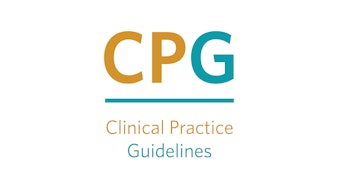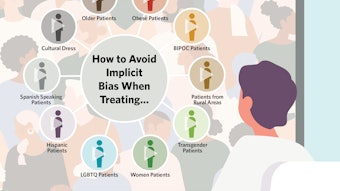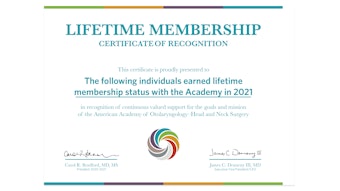Out of Committee: Patient Safety and Quality Improvement (PSQI) | Equitable Head and Neck Cancer Care
The delivery of equitable care is a pillar of quality according to the National Academy of Medicine (formerly Institute of Medicine). Equitable care delivery is also a core component in the mission statement of many healthcare organizations.
Evan M. Graboyes, MD, MPH; Carol M. Lewis, MD, MPH; John D. Cramer, MD; Chanita Hughes-Halbert, PhD

Strategies to improve the delivery of timely, equitable HNC care are therefore desperately needed to improve survival and decrease disparities in outcomes for patients with HNC.6,7 Delays initiating treatment,8,9 commencing postoperative radiation therapy,10,11 and completing the entire package of treatment (from surgery to the end of adjuvant therapy)12,13 disproportionately burden particular racial/ethnic groups and underinsured patients. These treatment delays are strongly associated with poor oncologic outcomes such as higher rates of recurrence and worse survival.14,15 The impact of these treatment delays on survival is large, comparable in magnitude to the excess mortality risk conferred by adverse pathologic features such as extranodal extension or positive margins.14,15
Prior to a diagnosis of HNC, suboptimal access to care and health literacy hinder detection and delay presentation to a healthcare provider. Regular dental visits are associated with an earlier stage at diagnosis for oral and pharyngeal cancer.16 However, certain racial/ethnic groups are less likely to have ever received oral cancer screening and are less likely to be screened by a physician.17,18 Once symptoms develop, patients with low health literacy are also more likely to hold fatalistic cancer beliefs such as “prevention is not possible” or “cancer is fatal” that may delay presentation to a healthcare provider.19
Once HNC is diagnosed, disparities in the delivery of timely HNC treatment lead to worse outcomes for certain groups. Several recent studies have begun to elucidate the underlying mechanisms for these delays. For example, a recent publication by Liao et al. identified the three most common reasons for delays initiating treatment as missed appointments, extensive pretreatment evaluation, and treatment refusal.9 A study by Divi et al. found that the key drivers of delays starting adjuvant radiation therapy were delayed dental extractions, delayed radiation oncology consults, and inadequate patient engagement.20 Others have expanded on these findings, suggesting that key determinants of delayed adjuvant radiation therapy also include inadequate education about the urgency and significance of timely adjuvant radiation therapy, postsurgical sequelae, insufficient care coordination and communication during care transitions, fragmentation of care across healthcare organizations, travel burden, and inadequate social support.21,22
Based on these studies, researchers have now begun applying quality improvement methodologies to improve the delivery of timely, equitable HNC care. A landmark paper from the head and neck team at Stanford University developed a multicomponent intervention targeting the three key drivers of delays starting adjuvant radiation therapy.20 Examples of intervention components included placing dental consults at the new patient visit, extracting indicated teeth concurrent with the surgical resection, placing a referral for adjuvant therapy at the new patient visit, and providing patient education about the timeline and steps necessary to start adjuvant radiation therapy. In this pilot study, the multicomponent intervention improved the delivery of timely guideline adherent adjuvant therapy by 11% (from 62% to 73%) relative to the time period prior to the intervention. A recent publication from the Medical University of South Carolina described the development of a navigation-based multilevel intervention targeting (1) patient education, (2) travel support, (3) a standardized process for initiating the discussion of expectations for adjuvant therapy, (4) adjuvant therapy care plans, (5) referral tracking and follow-up, and (6) organizational restructuring.23 In this pilot study, the rate of timely, guideline-adherent adjuvant therapy was 86% overall and 100% for African American patients. Collectively, these studies provide exciting preliminary data that the HNC care delivery system (1) is potentially modifiable through quality improvement and health systems interventions and (2) represents an appealing target to decrease mortality and racial disparities in survival for patients with HNC.
As we develop strategies to improve the delivery of timely, equitable care for patients with HNC, we can look to cancer care delivery models for other types of cancer with racial/ethnic disparities in access to care (e.g., breast, colon, lung) for guidance.24 For example, patient navigation is a patient-centered, healthcare delivery intervention that aims to eliminate barriers to cancer care, thereby improving outcomes and decreasing disparities in health. There is a strong evidence base showing that patient navigation improves cancer screening and treatment initiation and decreases disparities in these outcomes.25 Although there is currently no screening test for patients with HNC, the principles underlying patient navigation are potentially applicable to improving timely HNC care. There is also growing recognition in other fields that quality improvement interventions to improve the delivery of timely, equitable cancer care should be multilevel in nature (e.g., target providers, healthcare team, and the organization).26
In conclusion, treatment delays are highly prevalent across the HNC treatment continuum, disproportionately burden racial/ethnic minorities and other medically vulnerable populations, and contribute to disparities in outcomes. Ongoing work is beginning to elucidate the mechanisms underlying treatment delay and resultant targeted quality improvement interventions have significant potential to improve the timeliness, equity, and quality of HNC care delivery. Continued efforts from academy members and collaborations between the American Academy of Otolaryngology–Head and Neck Surgery, the American Head and Neck Society, and other organizations will be necessary to drive meaningful change at the clinical practice and/or health system levels to improve the timeliness, equity, and quality of HNC care.
References
1. Institute on Medicine. Committee on Quality of Health Care in America. Crossing the Quality Chasm: A New Health System for the 21st Century. Washington, DC: National Academy Press, 2001.
2. Molina MA, Cheung MC, Perez EA et al. African American and poor patients have a dramatically worse prognosis for head and neck cancer: an examination of 20,915 patients. Cancer 2008;113(10):2797-2806.
3. Goodwin WJ, Thomas GR, Parker DF et al. Unequal burden of head and neck cancer in the United States. Head Neck 2008;30(3):358-71.
4. Jassal JS, Cramer JD. Explaining Racial Disparities in Surgically Treated Head and Neck Cancer. Laryngoscope 2021;131(5):1053-1059.
5. Graboyes E, Cramer J, Balakrishnan K et al. COVID-19 pandemic and health care disparities in head and neck cancer: Scanning the horizon. Head Neck 2020;42(7):1555-1559.
6. Houlton JJ. Defining Optimal Treatment Times in Head and Neck Cancer Care: What Are We Waiting For? JAMA Otolaryngol Head Neck Surg. 2019;145(2):177-178.
7. Graboyes EM, Hughes-Halbert C. Delivering Timely Head and Neck Cancer Care to an Underserved Urban Population-Better Late Than Never, but Never Late Is Better. JAMA Otolaryngol Head Neck Surg. 2019;145(11):1010-1011.
8. Murphy CT, Galloway TJ, Handorf EA et al. Increasing time to treatment initiation for head and neck cancer: an analysis of the National Cancer Database. Cancer. 2015;121(8):1204-1213.
9. Liao DZ, Schlecht NF, Rosenblatt G et al. Association of Delayed Time to Treatment Initiation With Overall Survival and Recurrence Among Patients With Head and Neck Squamous Cell Carcinoma in an Underserved Urban Population. JAMA Otolaryngol Head Neck Surg. 2019;145(11):1010-1011.
10. Graboyes EM, Garrett-Mayer E, Sharma AK, Lentsch EJ, Day TA. Adherence to National Comprehensive Cancer Network guidelines for time to initiation of postoperative radiation therapy for patients with head and neck cancer. Cancer. 2017;123(14):2651-2660.
11. Cramer JD, Speedy SE, Ferris RL, Rademaker AW, Patel UA, Samant S. National evaluation of multidisciplinary quality metrics for head and neck cancer. Cancer 2017;123(22):4372-4381.
12. Guttmann DM, Kobie J, Grover S et al. National disparities in treatment package time for resected locally advanced head and neck cancer and impact on overall survival. Head Neck 2018;40(6):1147-1155.
13. Tam M, Wu SP, Gerber N K et al. The impact of adjuvant chemoradiotherapy timing on survival of head and neck cancers. Laryngoscope 2018;128(10):2326-2332.
14. Graboyes E, Kompelli A, Neskey D et al. Association of Treatment Delays with Survival for Patients with Head and Neck Cancer. JAMA Otolaryngol Head Neck Surg. 2019;145(2):166-177.
15. Ho AS, Kim S, Tighiouart M et al. Quantitative survival impact of composite treatment delays in head and neck cancer. Cancer. 2018;124(15):3154-3162.
16. Langevin SM, Michaud DS, Eliot M, Peters ES, McClean MD, Kelsey KT. Regular dental visits are associated with earlier stage at diagnosis for oral and pharyngeal cancer. Cancer Causes Control. 2012;23:1821-1829.
17. Gupta A, Sonis S, Uppaluri R, Bergmark RW, Villa A. Disparities in Oral Cancer Screening Among Dental Professionals: NHANES 2011-2016. Am J Prev Med. 2019;57(4):447-457.
18. Kravietz A, Angara P, Le M, Sargi Z. Disparities in Screening for Head and Neck Cancer: Evidence from the NHANES, 2011-2014. Otolaryngol Head Neck Surg. 2018;159(4):683-691.
19. Fleary SA, Paasche-Orlow MK, Joseph P, Freund KM. The Relationship Between Health Literacy, Cancer Prevention Beliefs, and Cancer Prevention Behaviors. J Cancer Educ. 2019;34(5):958-965.
20. Divi V, Chen MM, Hara W et al. Reducing the Time from Surgery to Adjuvant Radiation Therapy: An Institutional Quality Improvement Project. Otolaryngol Head Neck Surg 2018;159(1):158-165.
21. Graboyes EM, Halbert CH, Li H et al. Barriers to the Delivery of Timely, Guideline-Adherent Adjuvant Therapy Among Patients With Head and Neck Cancer. JCO Oncol Pract. 2020; 16(12):e1417-e1432.
22. Sykes KJ, Morrow E, Smith JB et al. What is the hold up?-Mixed-methods analysis of postoperative radiotherapy delay in head and neck cancer. Head Neck. 2020;42(20):2948-2957.
23. Graboyes EM, Sterba KR, Li H et al. Development and Evaluation of a Navigation-Based, Multilevel Intervention to Improve the Delivery of Timely, Guideline-Adherent Adjuvant Therapy for Patients With Head and Neck Cancer. JCO Oncol Pract. 2021:OP2000943.
24. Cone EB, Marchese M, Paciotti M et al. Assessment of Time-to-Treatment Initiation and Survival in a Cohort of Patients With Common Cancers. JAMA Netw Open. 2020;3(12):e2030072.
25. Bernardo BM, Zhang X, Beverly Hery CM, Meadows RJ, Paskett ED. The efficacy and cost-effectiveness of patient navigation programs across the cancer continuum: A systematic review. Cancer. 2019;125(16):2747-2761.
26. Agurs-Collins T, Persky S, Paskett ED et al. Designing and Assessing Multilevel Interventions to Improve Minority Health and Reduce Health Disparities. Am J Public Health. 2019;109(S1):S86-S93.




















